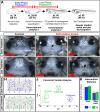Transcriptome analysis of Xenopus orofacial tissues deficient in retinoic acid receptor function
- PMID: 30390632
- PMCID: PMC6215681
- DOI: 10.1186/s12864-018-5186-8
Transcriptome analysis of Xenopus orofacial tissues deficient in retinoic acid receptor function
Abstract
Background: Development of the face and mouth is orchestrated by a large number of transcription factors, signaling pathways and epigenetic regulators. While we know many of these regulators, our understanding of how they interact with each other and implement changes in gene expression during orofacial development is still in its infancy. Therefore, this study focuses on uncovering potential cooperation between transcriptional regulators and one important signaling pathway, retinoic acid, during development of the midface.
Results: Transcriptome analyses was performed on facial tissues deficient for retinoic acid receptor function at two time points in development; early (35 hpf) just after the neural crest migrates and facial tissues are specified and later (60 hpf) when the mouth has formed and facial structures begin to differentiate. Functional and network analyses revealed that retinoic acid signaling could cooperate with novel epigenetic factors and calcium-NFAT signaling during early orofacial development. At the later stage, retinoic acid may work with WNT and BMP and regulate homeobox containing transcription factors. Finally, there is an overlap in genes dysregulated in Xenopus embryos with median clefts with human genes associated with similar orofacial defects.
Conclusions: This study uncovers novel signaling pathways required for orofacial development as well as pathways that could interact with retinoic acid signaling during the formation of the face. We show that frog faces are an important tool for studying orofacial development and birth defects.
Keywords: Cleft palate; Orofacial development; Retinoic acid; Transcriptomics; Xenopus laevis.
Conflict of interest statement
Ethics approval and consent to participate
All procedures using animals were approved by the VCU Institutional Animal Care and Use Committee (IACUC protocol number 5 AD20261).
Consent for publication
Not applicable to this study.
Competing interests
The authors declare that they have no competing interests.
Publisher’s Note
Springer Nature remains neutral with regard to jurisdictional claims in published maps and institutional affiliations.
Figures







Similar articles
-
E-liquids and vanillin flavoring disrupts retinoic acid signaling and causes craniofacial defects in Xenopus embryos.Dev Biol. 2022 Jan;481:14-29. doi: 10.1016/j.ydbio.2021.09.004. Epub 2021 Sep 17. Dev Biol. 2022. PMID: 34543654 Free PMC article.
-
The role of folate metabolism in orofacial development and clefting.Dev Biol. 2015 Sep 1;405(1):108-22. doi: 10.1016/j.ydbio.2015.07.001. Epub 2015 Jul 2. Dev Biol. 2015. PMID: 26144049 Free PMC article.
-
Median facial clefts in Xenopus laevis: roles of retinoic acid signaling and homeobox genes.Dev Biol. 2012 May 1;365(1):229-40. doi: 10.1016/j.ydbio.2012.02.033. Epub 2012 Mar 3. Dev Biol. 2012. PMID: 22405964
-
The expression of retinoic acid receptors in Xenopus development.Biochem Soc Trans. 1994 Aug;22(3):575-9. doi: 10.1042/bst0220575. Biochem Soc Trans. 1994. PMID: 7821640 Review. No abstract available.
-
Wnt signaling in orofacial clefts: crosstalk, pathogenesis and models.Dis Model Mech. 2019 Feb 4;12(2):dmm037051. doi: 10.1242/dmm.037051. Dis Model Mech. 2019. PMID: 30760477 Free PMC article. Review.
Cited by
-
Targeted single-cell RNA sequencing of transcription factors enhances the identification of cell types and trajectories.Genome Res. 2021 Jun;31(6):1069-1081. doi: 10.1101/gr.273961.120. Epub 2021 May 19. Genome Res. 2021. PMID: 34011578 Free PMC article.
-
E-liquids and vanillin flavoring disrupts retinoic acid signaling and causes craniofacial defects in Xenopus embryos.Dev Biol. 2022 Jan;481:14-29. doi: 10.1016/j.ydbio.2021.09.004. Epub 2021 Sep 17. Dev Biol. 2022. PMID: 34543654 Free PMC article.
-
Green tea extracts containing epigallocatechin-3-gallate modulate facial development in Down syndrome.Sci Rep. 2021 Feb 25;11(1):4715. doi: 10.1038/s41598-021-83757-1. Sci Rep. 2021. PMID: 33633179 Free PMC article.
-
Using an aquatic model, Xenopus laevis, to uncover the role of chromodomain 1 in craniofacial disorders.Genesis. 2021 Feb;59(1-2):e23394. doi: 10.1002/dvg.23394. Epub 2020 Sep 11. Genesis. 2021. PMID: 32918369 Free PMC article.
-
Retinoid-X receptor agonists increase thyroid hormone competence in lower jaw remodeling of pre-metamorphic Xenopus laevis tadpoles.PLoS One. 2022 Apr 13;17(4):e0266946. doi: 10.1371/journal.pone.0266946. eCollection 2022. PLoS One. 2022. PMID: 35417489 Free PMC article.
References
MeSH terms
Substances
Grants and funding
LinkOut - more resources
Full Text Sources
Molecular Biology Databases
Research Materials
Miscellaneous

